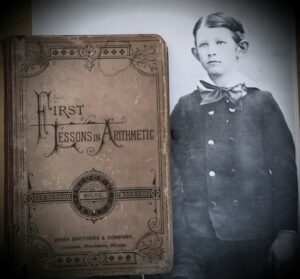The staff at the Kelley House Museum never cease to be amazed by the material the public presents to us as gifts. Take Auggie Heeser’s book, “First Lessons in Arithmetic” by William J. Milne, Ph. D., LL D. given to us by former Mendocino resident Deborah White.

As a former College of the Redwoods math instructor, somebody bought it for her as a gift – a price of $3.95 is penciled in it. She in turn thought the Kelley House would like it since Augustus A. “Auggie” Heeser (1877-1966) was publisher of the Mendocino Beacon for 60 years and played a major role in Mendocino’s history. His beautiful copperplate cursive signature is written inside the front cover, with a boyish, imperfect version scrawled along the margin on page 71.
Grammar school students used to have to purchase their own textbooks. Since this arithmetic book was published in 1881, we’re guessing he kept this slim brown volume from his childhood and added the adult signature at a later date. Sometime after his death in 1966, it ended up in a used bookstore.
Despite the book’s title of “First Lessons,” it is hard to know today if it was intended for one year’s learning, or several, and at what age a student would begin using it.
The authors used what was advertised as an “inductive” teaching approach. Lessons begin with counting, reading and writing numbers 1 to 20, then progress to addition, subtraction, multiplication, division, fractions, and Roman numerals.
“Slate Exercises” are given, as students had chalk and a piece of slate to practice upon. There is no place to write within the book, but little Heeser did write in pencil in the margins.
Almost every one of the 23 lessons includes an etching of a common scene and about 15 question-problems. A slate exercise instructs, “Make ten marks, and four marks on your slate. Fourteen is expressed thus. . . 14. How many books are ten books and four books?”
An addition problem reads, “A girl paid 1 cent for a needle and 6 cents for a spool of thread. How much did she pay for both?” A subtraction exercise says, “There were 11 passengers on the stagecoach, five of whom got out. How many remained?” A multiplication question asks, “What will 5 tons of hay cost at $4 a ton?” Division problems inquire, “When flour is $7 a barrel, how many barrels can be bought for $70?”
Then the problems get harder. “George, having 20 cents, paid 6 cents for candy and 8 cents for peanuts. How many cents did he have left?” A fraction lesson asks, “If a pound of candy is divided equally among 8 boys, what part of a pound will one boy receive?”
The book contains units of measure unfamiliar to many today. For example, “mills” were a unit of money, with ten mills making one cent. “Rods” measured length, and five- and one-half yards, or 16 feet equaled one rod. “How many feet are there in two rods plus five feet?” (Note: answers were never given.)
In dry measure math, 8 quarts equaled one peck and four pecks equaled one bushel. “How many pecks are there in two bushels?” Exercises in weight and time were also included.
The Kelley House Museum is always happy to receive items belonging to noteworthy persons, and we thank Deborah White for this donation. If you have an item or photograph to donate, please contact the curator via email curator@kelleyhousemuseum.org.